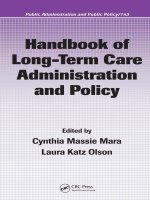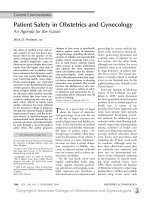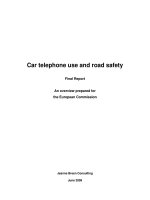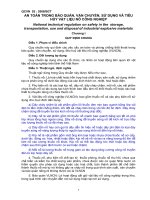Patient safety checklists use and policy
Bạn đang xem bản rút gọn của tài liệu. Xem và tải ngay bản đầy đủ của tài liệu tại đây (3.57 MB, 15 trang )
~
119-18
MESA VIEW
May 16, 2017
REGIONAL HOSPITAL
Rick Combs, Director
Legislative Counsel Bureau
401 S. Carson Street
Carson City, NV 89701-4747
Dear Mr. Combs:
Pursuant to NRS 439.877(4)(d) (AB280), which requires patient safety committees in medical facilities to
report annually on the facilities review, revision, and usage of patient safety checklists and policies, the
following is a summary of Mesa View Regional activities during 2016 and into 2017.
All checklists and policies were reviewed.
The Mesa View Regional Hospital Patient Safety Program Policy includes the patient safety and policy
compliance requirements. Attached you will find a report summarizing the specific checklists and
policies.
Please do not hesitate to contact me or my staff should you require additional information.
Sincerely,
)4
~~
Mary ~
Director Risk Management/Patient Safety Officer
Mesa View Regional Hospital
702-346-6036
1299 Bertha Howe Ave. • Mesquite, Nevada 89027 • (702) 346-8040 • Fax: (702) 346-7031 • www.mesaviewhospital.com
ii.
Procedure: (list by procedure)
Universal Protocol - prior to procedure performance
SAFE Protocol
Infant Car Seat Challenge
Blood Bank Infusion Checklist for Lab
Blood Infusion check list for nursing - in Electronic Medical Record
Pitocin Administration check list
Patient transfer checklist
VTE
Telemetry Triage List
Opiate Withdrawal checklist
Neuro checklist - in Electronic Medical Record
Alcohol Withdrawal checklist - in Electronic Medical Record
Burn Injury Report
Code Blue
Surgical Site Fire Risk Assessment
Anesthesia Orders
Anesthesia Pre-Operative Orders for Routine Cases
Colonoscopy/Esophagogastroduodenoscopy Orders
Orthopedic Procedure Discharge Instructions
Orthopedic Pre and Intra Operative Orders for Total/Hemi Joint Replacement
Adult Patient Controlled Analgesia (PCA) Orders
Morphine lmg/ml PCA Orders
GYN Pre-Operative Checklist and Orders
Parry Per-Operative Orders for Total Joint Replacement
Pre-Operative Assessment/Observation
Sliding Scale Insulin Orders
Physician Post-Operative Note
Operative Note
Pre-Anesthesia Evaluation
Transfusion Adverse Reaction
PACU Post-Surgical Record
Pre-Op Admission Check List
SBAR
Pre-arrival Pre-operative check list
Pre-Op Nursing Assessment
Pediatric Pre-Procedure History
PACU Medication Reconciliation Admission/Discharge
Outpatient Nursing Assessment
Intra Operative Record
Post Anesthesia Care Orders
Post Op Hourly Rounding
Transfusion Complication Form
Newborn Screening
iii. DC Checklists: (list by procedure)
AMI/Chest Pain/ACS Discharge Checklist
lmmunizations/VTE/Tobacco Checklist
General Discharge Checklist
Scrotal Incision Instructions
Circumcision Instructions
GYN Discharge Instructions
Orthopedic Procedure Discharge Instructions
b. Rehab:
i. Procedure: None - service out sourced
ii. Daily: None - service out sources
c.
Respiratory:
i. Procedure: VAP
OSA
Allen's Test
Focus Review Respiratory Therapy
ii. Daily: Oxygen Challenge
d. All staff:
i.
Patient Identification,
ii.
hand washing
e. Social Services:
i.
None - Service not available
ii.
None - Service not available
<
•
f.
Safety:
Medication Bar Code Scanning Administration of Medications
Bomb threat checklist
Clinical Alarm Safety
Procedure Caret Verification checklist
Code Blue Crash Cart Verification checklist
Mind ray Telemetry Problem Tracking
Telemetry log
Contrast Media Questionnaire
MRI Screening Questionnaire
Imaging Pregnancy Questionnaire
Restraint Order Checklist
Critical Assessment Team Record
ED-OB Handoff
Laboratory Quality Assurance Review
Centrifuge Maintenance log
UA Clinitec Maintenance log
CA-500 Series Checklist
Hematology Daily Maintenance Log
Histology/Spec Receiving Eye Wash/Shower Testing
Tissue Tracking and Disposition Log
Lab Maintenance Log
Frozen Section Log
Coagucheck
Laboratory Corrective Action log
Hand Hygiene Monitoring
Reference Laboratory Request
Report ofTransfusion Associated Infection
.
..
.
.
g. Environmental Services:
Housekeeping
checklists:
ED
Lab
Main Lobby
Wound Care & Offices
Imaging
Soiled Utilities
OR
Med/Surg
ICU
OB
Pharmacy
Dr. Lounge
Case Manager
Respiratory
Terminal Clean
PACU
Patient Rooms
OB
OR
h. Outside Vendors: - No check list utilized
5.
Patient Safety Committee approved all existing checklists for 2016 and reviews any new presentations at the
monthly Patient Safety Committee meetings in the new business agenda section.
6.
In 2016 we are unable to track checklists were completed by staff and vendors who supply services to
patients at Mesa View Hospital because it is too numerous to track, additionally some check lists are built
into the current Electronic Medical Record. During the year 2016 the hospital admitted 33,826 patients and
34,657 out patients. Most if not all of these patients had a check list performed.
Mesa View Regional Hospital
Page 1 of 1
Policy Title:
Audience: All Employees
References and Citations:
PURPOSE
The purpose of the Patient Safety Plan is to provide a systematic, coordinated and continuous
approach to the maintenance and improvement of patient safety through the establishment of
mechanisms that support effective responses to actual occurrences; ongoing proactive reduction in
medical/health care errors; and integration of patient safety priorities into the new design and redesign
of all relevant organization processes, functions and services. The goal of the Patient Safety Plan is to
provide a safe environment for patients and their families. The approach to optimal patient safety
involves multiple departments and disciplines in establishing the plans, processes and mechanisms
that comprise the patient safety activities at the Hospital. The purpose includes creating an environment
that encourages:
•
•
•
•
•
•
•
•
Recognition and acknowledgment of risks to patient safety and medical/health errors;
The initiation of actions to reduce these risks ;
The internal reporting of what has been found and the actions taken;
A focus on processes and systems;
Minimization of individual blame or retribution for involvement in a medical/healthcare error;
Organizational learning about medical/healthcare errors;
Support of the sharing of that knowledge to effect behavioral changes in itself and other health care
organizations; and
Disclosure of the outcomes of care, treatment and services.
The Patient Safety Plan developed by the interdisciplinary Patient Safety Committee and approved by
the Quality Improvement Council, the Medical Executive Committee, and the Board of Trustees,
outlines the components of the organization-wide Patient Safety Program.
SCOPE OF ACTIVITIES
The Patient Safety program is an organization-wide program that includes and integrates all activities
within the organization and CHS PSO, LLC. which contributes to the maintenance and improvement of
patient safety, healthcare quality and healthcare outcomes.
The scope of the Patient Safety Program involves an ongoing assessment, using internal and external
knowledge and experience, to prevent occurrence of errors and to maintain and improve patient safety.
Original Effective Date: 9/30/2004
Revision Date: 4/9/2017
Policy Title:
Page 2 of 9
Patient safety event information from aggregated data reports and individual event reports will be
reviewed by the Patient Safety Committee to prioritize organizational patient safety activity efforts.
In addition to internal knowledge and experience, the services and information that the CHS PSO, LLC.
offers will be reviewed and evaluated to include:
•
Best Practices and Took Kit Development;
•
Comparative Analysis of Adverse Event Reported in the Event Reporting System;
•
Unsafe Behavior Evaluations;
•
Raise safety awareness through the internal publication of anonymized Action Plans from root
cause analysis;
•
Develop and publish Patient Safety Alerts; and
•
Monthly Comprehensive Risk Assessments.
•
Review of checklists utilized in patient care and patient safety
Patient Safety Event Work Product:
Types of patient safety events, adverse outcomes, or medical/health care errors included in data
analysis are:
•
•
•
•
•
•
Event Reports- those events and outcomes reportable to the Director of Risk Management by
an Event Report (Form RM 3301) during downtime or by entering the occurrence into the Event
Reporting System include processes and outcomes of care that may result in no harm through
serious injury or death. Examples include falls, medication variances, adverse drug reactions,
intravenous therapy variances, procedure variances, procedure complications, patient
complaints and AMA and elopement discharges. These may also include near miss events.
Hemolytic transfusion reactions reported through the transfusion review channels.
Hazardous Condition - any set of circumstances, exclusive of the disease or condition for which
the patient is being treated, which significantly increases the likelihood of a serious physical or
psychological adverse patient outcome.
Serious Safety Event & Sentinel Event: applies to events that have resulted in an unanticipated
death or major permanent loss of function, not related to the natural course of the patient's
illness or underlying condition. In addition, there are other event types that are considered
sentinel due to the severity of the event even though the outcome was not death or permanent
loss of function unrelated to the natural course of the patient's illness or underlying condition.
Serious Safety Event & Sentinel event criteria and the procedures involved are detailed in the
sentinel event and root cause analysis policies and procedures including definitions of near
misses, which require a root cause analysis.
Never Events and Hospital Acquired Conditions including:
Surgical events:
•
Surgery performed on the wrong body part;
•
Surgery performed on the wrong patient;
•
Wrong surgical procedure performed on a patient;
•
Unintended retention of a foreign object in a patient after surgery or other procedure;
Original Effective Date: 9/30/2004
Revision Date: 4/9/2017
Policy Title:
Page 2 of 9
Patient safety event information from aggregated data reports and individual event reports will be
reviewed by the Patient Safety Committee to prioritize organizational patient safety activity efforts.
In addition to internal knowledge and experience, the services and information that the CHS PSO, LLC.
offers will be reviewed and evaluated to include:
•
Best Practices and Took Kit Development;
•
Comparative Analysis of Adverse Event Reported in the Event Reporting System;
•
Unsafe Behavior Evaluations;
•
Raise safety awareness through the internal publication of anonymized Action Plans from root
cause analysis;
•
Develop and publish Patient Safety Alerts; and
•
Monthly Comprehensive Risk Assessments.
•
Review of checklists utilized in patient care and patient safey
Patient Safety Event Work Product:
Types of patient safety events, adverse outcomes, or medical/health care errors included in data
analysis are:
•
•
•
•
•
•
Event Reports- those events and outcomes reportable to the Director of Risk Management by
an Event Report (Form RM 3301) during downtime or by entering the occurrence into the Event
Reporting System include processes and outcomes of care that may result in no harm through
serious injury or death. Examples include falls, medication variances , adverse drug reactions,
intravenous therapy variances, procedure variances, procedure complications, patient
complaints and AMA and elopement discharges. These may also include near miss events.
Hemolytic transfusion reactions reported through the transfusion review channels.
Hazardous Condition - any set of circumstances, exclusive of the disease or condition for which
the patient is being treated , which significantly increases the likelihood of a serious physical or
psychological adverse patient outcome.
Serious Safety Event & Sentinel Event: applies to events that have resulted in an unanticipated
death or major permanent loss of function, not related to the natural course of the patient's
illness or underlying condition. In addition, there are other event types that are considered
sentinel due to the severity of the event even though the outcome was not death or permanent
loss of function unrelated to the natural course of the patient's illness or underlying condition.
Serious Safety Event & Sentinel event criteria and the procedures involved are detailed in the
sentinel event and root cause analysis policies and procedures including definitions of near
misses, which require a root cause analysis.
Never Events and Hospital Acquired Conditions including:
Surgical events:
•
Surgery performed on the wrong body part;
•
Surgery performed on the wrong patient;
•
Wrong surgical procedure performed on a patient;
•
Unintended retention of a foreign object in a patient after surgery or other procedure;
Original Effective Date: 9/30/2004
Revision Date: 4/9/2017
Policy Title:
•
•
Page 3 of 9
lntraoperative or immediately postoperative death in an American Society of Anesthesiologists
Class I patient; or
Artificial insemination with the wrong sperm or donor egg
Product or device events:
•
Patient death or serious disability associated with the use of contaminated drugs, devices, or
biologics provided by the health care facility;
•
Patient death or serious disability associated with the use or function of a device in patient care,
in which the device is used for functions other than as intended; or
•
Patient death or serious disability associated with intravascular air embolism that occurs while
being cared for in a health care facility e.g., luer connecters are implicated in or contribute to
many of these errors because they enable functionality of dissimilar tubes to be connected .
Patient protection events:
•
Infant discharged to the wrong person;
•
Patient death or serious disability associated with patient elopement (disappearance); or
•
Patient suicide or attempted suicide resulting in serious disability, while being cared for in a
health care facility
Care management events:
•
Patient death or serious disability associated with a medication error (e.g., errors involving the
wrong drug, wrong dose, wrong patient, wrong time, wrong rate, wrong preparation, or wrong
route of administration);
•
Patient death or serious disability associated with a hemolytic reaction due to the administration
of ABO/HLA-incompatible blood or blood products;
•
Maternal death or serious disability associated with labor or delivery in a low-risk pregnancy
while being cared for in a health care facility;
•
Patient death or serious disability associated with hypoglycemia, the onset of which occurs
while the patient is being cared for in a health care facility;
•
Death or serious disability (kernicterus) associated with failure to identify and treat
hyperbilirubinemia in neonates;
•
Stage 3 or 4 pressure ulcers acquired after admission to a health care facility; or
•
Patient death or serious disability due to spinal manipulative therapy
Environmental events:
•
Patient death or serious disability associated with an electric shock or electrical cardio-version
while being cared for in a health care facility;
•
Any incident in which a line designated for oxygen or other gas to be delivered to a patient
contains the wrong gas or is contaminated by toxic substances;
•
Patient death or serious disability associated with a burn incurred from any source while being
cared for in a health care facility;
•
Patient death or serious disability associated with a fall while being cared for in a health care
facility; or
Original Effective Date: 9/30/2004
Revision Date: 4/9/201 7
Policy Title:
•
Page 4 of 9
Patient death or serious disability associated with the use of restraints or bedrails while being
cared for in a health care facility.
Criminal events:
•
Any instance of care ordered by or provided by someone impersonating a physician, nurse,
pharmacist, or other licensed health care provider
•
Abduction of a patient of any age;
•
Sexual assault on a patient within or on the grounds of the health care facility;
•
Death or significant injury of a patient or staff member resulting from a physical assault (i.e.,
battery) that occurs within or on the grounds of the health care facility; or
•
Environment of care significant incidents involving employee, visitor, utility or property damage
Sources of external knowledge and experience include the Sentinel Event Alerts. Published by The
Joint Commission, safety alerts published by the Food and Drug Administration, Patient Safety Alerts,
adverse outcome and lessons learned from RCA's, information from insurance carriers and other
private and public healthcare safety organizations.
The scope of the organization-wide Safety Program encompasses all people including the patient
population, visitors, volunteers and staff (including medical staff). The program addresses maintenance
and improvement in patient safety issues in every department throughout the facility, as well as
employee safety, physical plant and facilities, equipment and supply-related safety issues, among other
safety issues. To promote efficiency, there is an Environment of Care Committee, chaired by the
Environmental Safety Officer, that addresses employee events and safety, workers
compensation, needle sticks and products, visitor Events, hazard surveillance, and the safety
management plans. To promote integration, communication and analysis of inter-related issues, there
is cross membership between the committees, and both committees report to the Quality Improvement
Council for oversight and further integration of related issues. Physician peer review of medical errors is
also conducted at the Quality Improvement Council level (or at their direction) .
The Serious Safety Event Rate (SSER) calculation will then be reviewed on a monthly basis. The
SSER should be considered Patient Safety Work Product and will be reported to the following
council/committees, Patient Safety, Quality Improvement, Medical Executive and the Board of
Directors. This rate will also be reported to the Patient Safety Committee and the CHS PSO.
The Patient Safety Committee is composed of a physician chairperson who is also a member of, and
liaison to, the Quality Improvement Council. Other members include the Chief Quality Officer/QMRC,
administrative representation such as the assistant CEO or COO, nursing leadership representative(s),
including hospital, long term care, a pharmacist, and appropriate other medical and organization staff.
The meeting frequency should be at least quarterly. The Patient Safety Committee will appoint a
Patient Safety Officer. The organizations' Director of Risk Management will serve as the Patient Safety
Officer in most instances.
Original Effective Date: 9/30/2004
Revision Date: 4/9/2017
Policy Title:
Page 5 of 9
Procedures
Committee responsibilities:
1.
The interdisciplinary Patient Safety Committee is responsible for the oversight and management
of the Patient Safety Program. This includes making recommendations to organization leaders
regarding the adequacy of resources allocated to support patient safety activities. The
committee will oversee data and analysis in order to prioritize patient safety activities, including,
but not limited to patient safety work product, Medication Variances, Infection Surveillance,
Safety Surveillance, Staff Perceptions of and suggestions for improving patient safety, Staff
willingness to report errors (Employee Surveys), Patient/Family perceptions of, and suggestions
for improving patient safety, and results of risk assessment surveys by department.
2.
The Patient Safety Committee is responsible to review and approve the organization-wide and
departmental patient safety-related policies, procedures and CHS PSO information. This should
include the content of any proactive risk self-assessments prior to data collection , as well as
patient/family education regarding their role in helping to facilitate the safe delivery of care.
All departments within the organization (patient care and non-patient care departments) are
responsible to report patient safety occurrences, and potential occurrences to the Director of
Risk Management, who will aggregate occurrence information and present a report to the
Patient Safety Committee on a quarterly basis. This Patient Safety Work Product report will
contain aggregated information related to the cause or nature of the occurrence, severity of
occurrence , number/type of occurrences per department, occurrence impact on the patient,
improvement actions taken, and patient outcome. The Patient Safety Committee will analyze
the report information and determine further patient safety activities as appropriate. Any
undesirable patterns or trends in patient safety and sentinel events should be intensively
analyzed. Intense analysis involves studying a process to learn in greater detail about how it is
performed or how it operates, how it can malfunction, and how errors occur.
3.
Patient complaints and concerns or ideas about patient safety should be reported to and
evaluated by the Patient Safety Committee. Patient safety information input regarding employee
willingness to report and related information from patient and employee surveys should be
reviewed and evaluated by the Patient Safety Committee. (Resolution of individual patient
complaints is handled by the personnel so designated by the organization.)
4.
The Patient Safety Committee reviews alerts or guidance from external sources, including T JC,
Institute for Safe Medication Practices, the Food and Drug Administration and consider whether
their recommendations should and could be implemented at the organization as a proactive
measure to reduce patient safety risks.
5.
Patient safety occurrences requiring a report to an external agency such the F.D.A. , Board of
Pharmacy, Center for Medicare Administration, a manufacturer or the state department of
health, should also be reported to the Patient Safety Committee. This report should include an
Original Effective Date: 9/30/2004
Revision Date: 4/9/2017
Policy Title:
Page 6 of 9
analysis of the occurrence as to underlying causes, any improvement actions recommended
and/or taken and, when available, the results of those improvement actions.
6.
Through review of internal data reports and reports from external sources (including T JC
sentinel event report information, and other sources such as available occurrence reporting
information from state and federal sources and current literature), and through the Quality
Improvement priority criteria grid, the Patient Safety Committee will select at least one high-risk
safety process for proactive risk assessment annually using a Failure Mode Effects Analysis
methodology.
The proactive risk assessment will include:
•
•
•
•
•
•
Assessment of the intended and actual implementation of the process to identify the steps in
the process where there is, or may be, undesirable
variation (failure mode). For each identified failure mode, identify the possible effects of the
undesirable variation on patients, and how serious the possible effect on the patient could
be (criticality);
For the most critical effects, conduct a root cause analysis to determine why the variation
(failure mode) leading to that effect may occur;
Redesign the process and/or underlying systems to minimize the risk of that failure mode or
to protect patients from the effects of that failure mode;
Test and implement the redesigned process;
Identify and implement measures of the effectiveness of the redesigned process; and
Implement a strategy for maintaining the effectiveness of the redesigned process over time.
Organization-wide activities:
1. Education regarding employee responsibilities for patient safety is included in initial and annual
orientation programs, both by the Director of Risk Management and department manager. This
includes reporting requirements and mechanisms. As appropriate, training which incorporates
methods of team training to foster an interdisciplinary, collaborative approach to patient care
delivery is provided. The Patient Safety Committee and other committees may recommend
education as a patient safety improvement activity at any time throughout the year. Training on
failure mode analysis, effects and criticality analysis should be done for those involved with this
risk reduction tool.
2. Patient safety is included as a regular agenda item for at least the clinical and support service
departments of the organization. The intent is to foster a culture of "patient safety as job number
one", "Safety First". Patient safety is a high priority function in the design and redesign of
processes, functions and systems that impact or involve patient care.
3. At any given time, the performance of critical steps in at least one high-risk process is the
subject of ongoing measurement and periodic analysis to determine the degree of variation from
intended performance.
Original Effective Date: 9/30/2004
Revision Date: 4/9/2017
Policy Title:
Page 7 of9
4. Initiate and comply with TJC National Patient Safety Goals, and/or other regulatory or
accrediting standards, by implementing the goals' elements of performance to improve Patient
Safety.
Actions upon Error or Event:
Upon identification of a medical/health care error/event, the patient care provider should:
•
•
•
•
•
•
As appropriate to the occurrence, perform healthcare interventions to contain the risk to the
patient or others
Contact the patient's attending physician and other physicians, as appropriate, to report the
error or event, carrying out physician orders as necessary.
Contact the patient's family, guardian, Power of Attorney or significant other to make aware
of the error or event. Refer to the Disclosure of Treatment Outcomes policy.
Preserve any information (Preservation Checklist) related to the error or event (including
physical information). Examples of preservation of physical information are: Removal and
preservation of blood unit for a suspected transfusion reaction; preservation of IV tubing,
fluids bags and/or pumps for a patient with a severe drug reaction from IV medication;
preservation of medication label for medications administered to the incorrect patient.
Preservation of information includes documenting the facts regarding the error on an Event
Report, and in the medical record as appropriate to organizational policy and procedure.
Report the medical/health care error to the staff member's immediate supervisor.
Submit the Event Report to the Director of Risk Manager per the Patient Safety Evaluation
System.
Individuals in any department identifying a potential patient safety issue should notify their
supervisor and document the findings on an Event Report. This Patient Safety Work Product
includes patient safety near misses. The Event Report should be submitted to the Director of Risk
Manager per organizational policy.
Staff response to medical/health care occurrences is dependent upon the type of occurrence
identified:
• Hazardous Condition/Patient Safety Issue - as appropriate, and if possible, staff will contain
the hazardous condition or patient safety issue. Staff identifying a hazardous condition or
potential patient safety issue should notify their supervisor and document the findings on an
Event Report form . The Event Report form will be submitted to the Director of Risk Manager
per organizational policy
• Serious Safety Event & Sentinel Event - staff should perform any necessary clinical
interventions to support and protect the patient and notify the physician staff responsible for
the patient, carrying out any necessary physician orders. Staff will then follow the
organizational Sentinel Event Policy and Procedure. A root cause analysis should be
performed for any sentinel event and near miss as defined in the sentinel event policy and
procedure.
• Near Miss - staff should report the near miss event to their immediate supervisor, describe
the facts of the near miss on an event report and submit the report to the Director of Risk
Original Effective Date: 9/30/2004
Revision Date: 4/9/2017
Policy Title:
Page 8 of 9
Manager. A proactive risk assessment may be performed to prevent recurrence if it is
determined that a recurrence poses a significant safety risk to future patients. This may be
determined by the Director of Risk Manager and/or the Patient Safety Committee if there is
any disagreement as to risk potential.
An effective Patient Safety Program cannot exist without optimal reporting of medical/health care errors
and occurrences. Therefore, it is the intent of this organization to adopt a non-punitive approach in its
management of errors and occurrences. All personnel are required to report suspected and identified
medical/health care errors, and should do so without the fear of reprisal in relation to their employment.
This organization supports the concept that errors occur due to a breakdown in systems and
processes, and will focus on improving systems and processes, rather than disciplining those
responsible for errors and occurrences. A focus will be placed on remedial actions to assist rather than
punish staff members.
Staff Support:
Staff members involved in a sentinel event occurrence will receive support from the Director of Risk
Manager regarding the staff member's professional and emotional reconciliation of the sentinel
event. The staff member's involvement in the root cause analysis and action plan processes is
encouraged, to allow the staff member an active role in process resolution. Additionally, any staff
member involved in a sentinel event or other medical/health care error may request and receive
supportive personal counseling from the hospital's social worker, psychologist or psychiatrist on
staff and/or their department supervisor.
Disclosure:
Patients, and when appropriate, their families are informed regarding the unanticipated outcomes of
care, or when the outcomes differ significantly from the anticipated outcomes. The Patient Safety
Committee will monitor for compliance with this standard through the information management
function of record reviews, and through reports from the Patient Safety Officer of evidence found
upon individual record review for other risk management purposes. (See also policy regarding
disclosure of unanticipated outcomes.)
Communication1. Medical/health care errors and occurrences, including sentinel events, will be reported to the
CHS PSO, LLC and externally, per hospital policy through the channels established by this plan.
External reporting will be performed in accordance with state, federal and regulatory body rules,
laws and requirements (i.e., regarding medical devices in accordance with the Safe Medical
Devices Act.).
2. An annual report will be compiled by the Patient Safety Committee and forwarded to the Quality
Improvement Council, the Medical Executive Committee and on to the governing board. This
report shall include at least aggregate data regarding patient safety, an analysis thereof
(conclusions}, recommendations and actions taken to improve patient safety, both in response
to actual occurrences and proactively. These reports shall be protected to the extent allowable
Original Effective Date: 9/30/2004
Revision Date: 4/9/2017
'I,
I
I
f'
Policy Title:
Page 9 of 9
under the disclosure laws applicable to peer review, the Quality Improvement Council, and risk
management.
3. The governing board, upon evaluation of received reports (at a minimum, annually), should
assess the allocation of resources, the assignment of personnel and their time, the provision of
information services and data management processes, and staff training in terms of adequacy
of their allocation of human, information, physical and financial resources to support patient
safety improvement priorities.
Patient and Family Education:
The organization urges patients and families to get involved in their care. Educational efforts to
increase consumer awareness and involvement are supported by the Centers for Medicare and
Medicaid Services and TJC as a critical process to improve patient safety. The organization
encourages patients and families to:
• Speak up if they have questions or concerns, and if they don't understand, ask again.
Encouraging patients that it is their right to know
• Pay attention to the care received. Making sure you are getting the right treatments and
medications by the right health care professionals. Don't assume anything.
• Educate yourself about diagnosis, the medical tests you are undergoing and your treatment
plan.
• Ask a trusted family member or friend to be your advocate.
• Know what medications you take and why you take them. Medication errors are the most
common health care mistakes.
• And to participate in all decisions about your treatment. You are the center of the health care
team.
Original Effective Date: 9/30/2004
Revision Date: 4/9/2017









